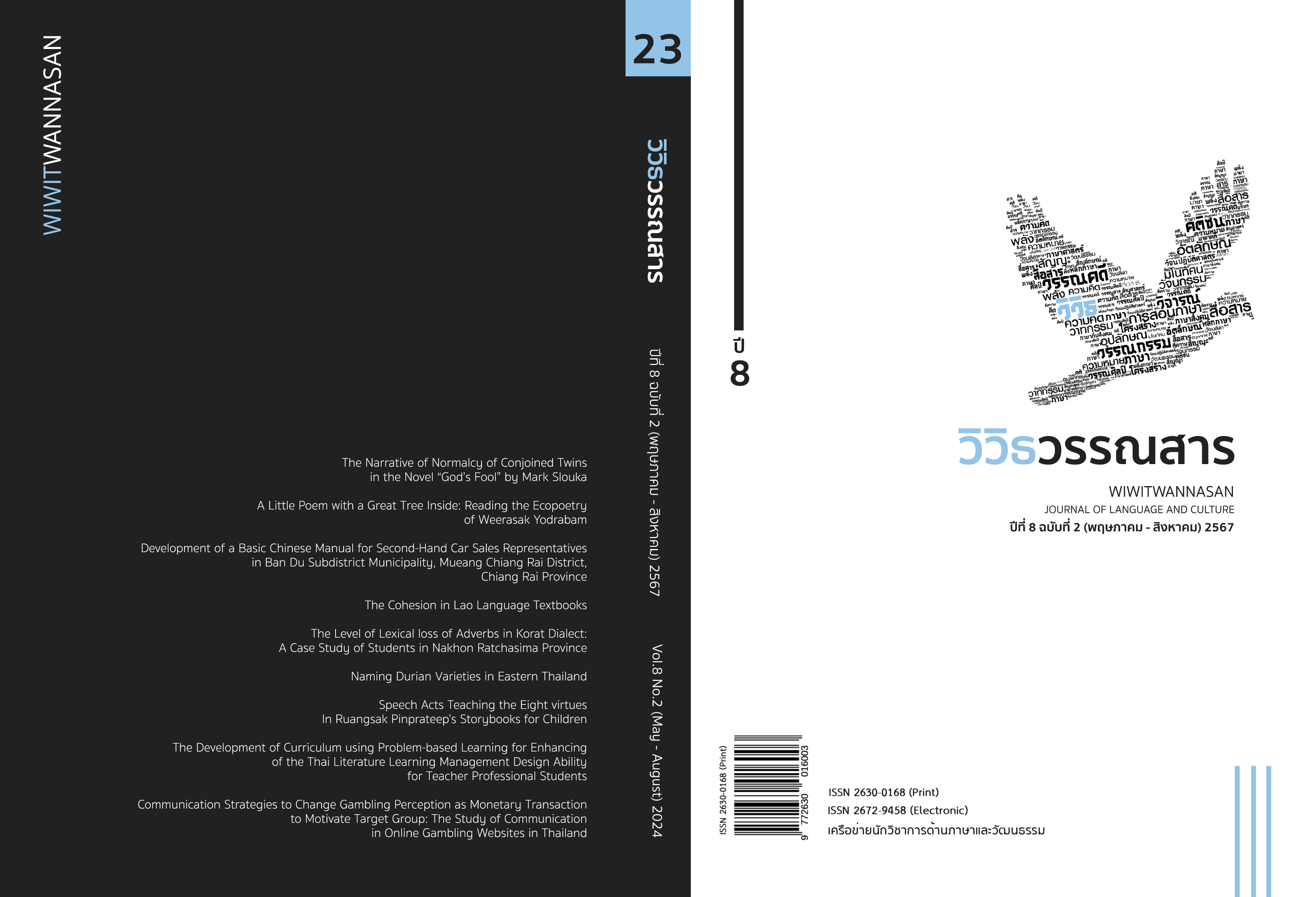การศึกษาวัจนกรรมการสอนคุณธรรม 8 ประการในหนังสือนิทานสำหรับเด็ก ของเรืองศักดิ์ ปิ่นประทีป
Main Article Content
บทคัดย่อ
การวิจัยนี้มีวัตถุประสงค์เพื่อวิเคราะห์คุณธรรม 8 ประการที่ปรากฏในหนังสือนิทานสำหรับเด็กของเรืองศักดิ์ ปิ่นประทีปและวิเคราะห์ประเภทวัจนกรรมการสอนคุณธรรม 8 ประการที่ปรากฏในหนังสือนิทานสำหรับเด็กของเรืองศักดิ์ ปิ่นประทีป จำนวน 32 เรื่อง โดยใช้กรอบแนวคิดคุณธรรม 8 ประการของกระทรวงศึกษาธิการเป็นเกณฑ์ได้แก่ 1) ขยัน 2) ประหยัด 3) ซื่อสัตย์ 4) มีวินัย 5) สุภาพ 6) สะอาด
7) สามัคคี 8) มีน้ำใจ และกรอบการวิเคราะห์วัจนกรรมการสอนคุณธรรม ที่ประยุกต์จากแนวคิดของ John R. Searle 5 ประเภท คือ 1) วัจนกรรมการกล่าวความจริงหรือการบอกกล่าว 2) วัจนกรรมการกล่าวชี้นำ 3) วัจนกรรมการกล่าวผูกพัน 4) วัจนกรรมการกล่าวแสดงความรู้สึก 5) วัจนกรรมการกล่าวประกาศหรือแถลงการณ์
ผลการศึกษาคุณธรรม 8 ประการ พบคุณธรรมครบทุกด้านโดยเรียงข้อมูลจากการพบความถี่มากที่สุดคือ คุณธรรมด้านความมีน้ำใจ พบความถี่ 18 ครั้ง คิดเป็นร้อยละ 56.25 คุณธรรมด้านความมีวินัย, ความสะอาด, ความสามัคคี พบความถี่ 7 ครั้ง คิดเป็นร้อยละ 21.88 คุณธรรมด้านความสุภาพ พบความถี่
5 ครั้ง คิดเป็นร้อยละ 15.63 คุณธรรมด้านความขยันและคุณธรรมด้านความประหยัด พบความถี่เท่ากัน
2 ครั้ง คิดเป็นร้อยละ 6.25 คุณธรรมความซื่อสัตย์พบความถี่ 1 ครั้ง คิดเป็นร้อยละ 3.12 ตามลำดับ
ผลการศึกษาวัจนกรรมการสอนคุณธรรม พบวัจนกรรม 4 ประเภท ซึ่งโดยเรียงข้อมูล
จากการพบความถี่มากที่สุดคือ วัจนกรรมกล่าวความจริง หรือการบอกกล่าว พบความถี่ 21 ครั้ง คิดเป็นร้อยละ 65.63 วัจนกรรมกล่าวชี้นำ พบความถี่ 14 ครั้ง คิดเป็นร้อยละ 43.75 วัจนกรรมการกล่าวแสดงความรู้สึก
พบความถี่ 7 ครั้ง คิดเป็นร้อยละ 21.88 วัจนกรรมการกล่าวผูกพัน พบความถี่ 5 ครั้ง คิดเป็นร้อยละ 15.63 ตามลำดับ
Article Details

อนุญาตภายใต้เงื่อนไข Creative Commons Attribution-NonCommercial-NoDerivatives 4.0 International License.
ลิขสิทธิ์ของบทความเป็นของวารสาร การพิมพ์ซ้ำจะต้องได้ร้บการอนุญาตจากบรรณาธิการวารสาร
เอกสารอ้างอิง
Deephueng, S. (2006). Introduction to Pragmatics. Nakhon Pathom: Institute of Language and Culture for Rural Development, Mahidol University. (In Thai)
Dondee, K. (2015). Analysis of the virtue appearing in masterpiece of World folktales [Master’s thesis]. Naresuan University. (In Thai)
Hassajamnong, K., & Liamprawat, S. (2019). Speech Act Usage in Song of State Institutions of Higher Education. Humanities Journal Social Sciences and Arts Silpakorn University, 12 (3), 120. (In Thai)
Jumpit, S., Siripanumas, P., & Phoncharoen, S. (2014). Guidelines for developing the 8 Basic Moralities of Students Banprakong School under Buriram Primary Educational Service Area Office 1. Academic journal Buriram Rajabhat University, 6 (1), 120. (In Thai)
Khraiboot, A., & Kingkham, W. (2016). Speech Acts in Patriotic Songs During B.E.2510-2550. Nakhon Phanom University Journal, 6 (1), 61-69. (In Thai)
Khrutmuang, S. (1997). Teaching the democratic way of life through folk tales in the northern region. Phitsanulok: Thai family. (In Thai)
Limsadapong, K. (2020). Speech Acts in Better Life Counseling in Dhamma Daily Columm of Secret Magazine [Master’s thesis]. Thaksin University. (In Thai)
Ministry of Education. (2009, November 15). Educational reform with Eight basic morals that should be taught. https://www.moe.go.th/8
Sitthisaman, S. (2010, February 22). Bookstart: Books can change lives. https://www.moe.go.th/bookstart. (In Thai)
Stus, S. (2022). A comparative Study of Morals Appeared in Folktales Between Thailand and the Lao People's Democratic Republic of Lao. Journal of Lampang Rajabhat University, 11 (1), 123.
Summat, K., & Nillwannapha, R. (2021). Using Speech Acts in dharma’ books Vipassana Isan for Teaching monks. Journal of Social Science and Buddhistic Anthropology, 6 (1), 162-180.
Thuppong. (2017a). Help each other...that's good (5th ed.). Happy Kids. (In Thai)
Thuppong. (2017b). Little hands plant (4th ed.). Happy Kids. (In Thai)
Thuppong. (2017c). Understand...Understand (2nd ed.). Happy Kids. (In Thai)
Thuppong. (2017d). You can keep it and give it back (7th ed.). Happy Kids. (In Thai)
Thuppong. (2018). Making garlands...for Songkran Day (4th ed.). Happy Kids. (In Thai)
Thuppong. (2022a). Hello little monkey (9th ed.). Hello Kids. (In Thai)
Thuppong. (2022b). The Busy Working Ant and the Singing Cicada (24th ed.). Happy Kids. (In Thai)
Thuppong. (2022c). The little monkey is so clever (2nd ed.). Bangkok: Hello Kids. (In Thai)


